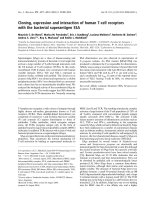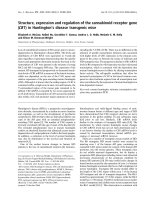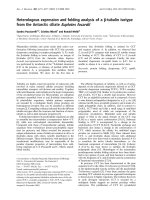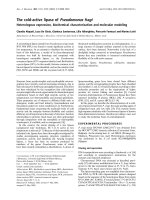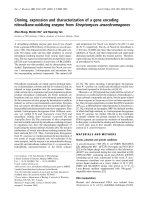Báo cáo y học: "The expression and significance of protooncogene c-fos in viral myocarditis" pot
Bạn đang xem bản rút gọn của tài liệu. Xem và tải ngay bản đầy đủ của tài liệu tại đây (755.81 KB, 7 trang )
RESEARC H Open Access
The expression and significance of proto-
oncogene c-fos in viral myocarditis
Song Zhang
1,2,3
, Ben He
1*
, Steven Goldstein
4
, Junbo Ge
3
, Zuyue Wang
4
, George Ruiz
4
Abstract
Background: c-fos may play a role in the pathogenesis of some diseases. The expression and function of c-fos in
viral myocarditis (VMC) have not yet been reported. To study the change and significance of proto-oncogene c-fos
in VMC is the objective of this experiment.
Methods: An animal model of VMC was established via coxsackie virus B
3
inoculation. VMC mice were then
treated with a c-fos monoclonal antibody and isoproterenol and the protein and mRNA expression of c-fos were
studied via immunohistochemical analysis and in situ hybridization. Results were simultaneously analyzed for the
significance of c-fos expre ssion in mice with VMC.
Results: Myocardial necrosis and cell infiltration decreased after treatment with c-fos monoclonal antibody
compared to control mice, while myocardial necrosis and cell infiltration were increased after treatment with
isoproterenol. Positive cardiomyocytes with c-Fos expression increased at 3, 5, 7, 9, and 15 days after virus
inoculation in VMC mice compared to control mice, while returning to almost normal levels at 35 days. The
expression level of c-fos mRNA at 3 and 7 days after virus inoculation in VMC mice was also higher than that of
control mice.
Conclusions: c-fos expression in the cardiomyocytes of VMC mice is significantly increased, c-fos plays an
important role in myocardial lesions. The apparent increase in expression of c-fos is likely to be involved in the
pathogenesis of VMC.
Background
The proto-oncogene c-fos participates in a variety of
physiological process including cell growth, differentia-
tion, transformation, signal transduction, and plasticity
of the nervous system [1]. The expression of c-fos is
known to be increased in particular diseases and patho-
physiological processes, indicating that it may play a
role in the pathogenesis of some disease s. The expres-
sion and function of c-fos in viral myocarditis (VMC)
have not yet been reported. Therefore, our experiments
were focused on the st udy of the expression of c-fos in
VMC by ways of immunohistochemic al analysis and
in situ hybridization. Simultaneously, we investigated
the significance of c-fos in VMC via medicine treatment
with c-fos monoclonal antibody or isoproterenol.
Materials and Methods
Animals
BALB/c mice, male, 4-6 weeks old, 16-20 grams.
Main reagents
c-fos monoclonal antibody, isoproterenol, normal goat
serum, rabbit anti-c-fos oncogene protein, Biotinylated
goat anti rabbit IgG, Streptavidin Biotin-peroxidase
Complex (SABC), antigen restoration solution, pepsin,
c-fos oligonucleotide probe, Occlusive solution, and rab-
bit anti digoxin were purchased from Boster Biological
Technology Ltd.(Wuhan, China), Sigma Chemical Co.
(Sigma, St.Louis, MO) and Biocompare Co.(South San
Francisco, CA).
Establishing of animal model (VMC)
130 mice were divided into two groups: the experimen-
tal group (120 mice) and t he control group (10 mice).
Each mouse of the experimental group was inoculated
with coxsackie virus B
3
(CVB
3
), while control mice were
* Correspondence:
1
Department of Cardiovascular Diseases, Eastern District of Renji Hospital,
Shanghai Jiaotong University, 1630 Dongfang Road, Shanghai, 200127, China
Full list of author information is available at the end of the article
Zhang et al. Virology Journal 2010, 7:285
/>© 2010 Zhang et al; licensee BioMed Central Ltd. This is an Open Access article distributed under the terms of the Creative Commons
Attribution License (http://creative commons.org/licenses/by/2.0), which permits unrestricted use, distribution, and reproduction in
any medium, provided the original work is properly cited.
inoculated with MEM 0.1 mL Eagle’ ssolution.Experi-
mental mice were sacrificed at day (D) 3, 5, 7, 9, 15, and
35 after inoculation (Groups D
3
,D
5
,D
7
,D
9
,D
15,
and
D
35
). 120 mice were included in the experiment group,
but some mice died, some mice lost, some mice bit each
other lead to death and also because of some other rea-
sons, we only got 60 specimens at last. Dead mice num-
ber of every sub-group: 5 in GroupD
3
, 6 in Group D
5
,8
in Group D
7
,7inGroupD
9
,8inGroupD
15
and 7 in
Group D
35
.
Medicine treatment
Another one hundred and twenty mice were divided
into three groups of 40 mice each (GroupE
1,
E
2,
and E
3
).
Each group of m ice was inocu lated with 0.1 mL of cox-
sackie virus B
3
(CVB
3
). Each mice of Group E
1
was then
inoculated with 5 μg of c-fos monoclonal antibody via
intraperitoneal injection every day for 3 days. Group E
2
mice were inoculated with 1 μ g of isoproterenol every
day for three days. Group E
3
mice were inoculated with
0.1 mL of normal saline for three days. Each group was
divided into two subgroups (20 mice/subgroup), i n
which one subgroup was sacrificed on day 7, and the
other was sacrificed at day 15.
Specimen collection
Serum was isolated from blood samples and refrigerated
for further use. Each heart specimen was divided into
two portions, in which one portion was fixed with 10%
methanol. Paraffin-embedded tissue samples were cut
into 5 μm sections and stained with hematoxyline/eosin
according to s tandard proce dures and observe d under a
light microscope (Olympus). The remaining portion of
the sample was preserved with glutaric dialdehyde to be
used for electron microscopy.
Immunohistochemical and in situ analysis of the c-fos
oncogone
Heart specimens were fixed in 10% methan ol for 24
hours and paraffin-embedded tissue samples were cut
into 5 μm sections. 5 sections were used i n every exam-
ple, sectio ns were mounted on 3-aminopropyltriethoxy-
silane (APES) treated slides followed by incubation at
56°C for 1-2 hours, followe d by 37°C incubation for
3 days.
Immunohistochemical analysis of c-Fos oncogene pro-
tein: After standard deparaffination and rehydration,
specimens were exposed to xylol for 10 minutes, 100%
alcohol for 5 minutes, 96% alcohol for 5 minutes, and
70% alcohol for 3 minutes. Endogenous peroxidase
activity was quenc hed by exposure to 3% hydrogen per -
oxide for 10 minutes. The antigen was restored by
citrate-buffered (pH 6.0). Normal goat serum was added
for 10 minutes at room temperature, c-Fos antibody was
added at 37°C for 1.5 hours followed by washing with
phosphate-buffered saline (PBS). Biotinylated goat anti-
rabbit IgG was added for 20 minutes at 37°C follo wed
by a PBS wash. Streptavidin Biotin-peroxidase Complex
(SABC) was added for 20 minutes at 37°C and then
rinsed with PBS. The color was then developed with dia-
minobenzidine (DAB) at room temperature, and rinsed
with distilled water after the reactive time was con-
trolled under the light microscope. Sections were
restained with hematoxylin, and incubated at 37°C and
sealed with neutral gum. Slides were observed under the
light microscope.
In sit u hybridization of the c-fos oncogene: Formalin-
fixed paraffin-embedded heart specimens were deparaffi-
nized with xylene and rehydrated with graded ethanol.
Theendogenousperoxidaseactivitywasquenchedby
exposure to 3% hydrogen peroxide for 10 minutes. Sam-
ples were then incubated with pepsin (diluted with 3%
citric acid) at 37°C for 20 minutes and rinsed with 0.5
M PBS and distilled water.
The Digoxin-labeled probe was added to t he sections
and sections were then covered with coverslips and
incubated overnight at 37°C. Af ter the coverslips were
disclosed, the s ections were rinsed w ith 2×SSC (17.6 g
sodium chloride and 8.8 g sodium citrate in 1000 mL of
distilled water), and 0.2 × SSC (1:10 dilutio n from
2×SSC). Rabbit anti-Digoxin was added to the sections
for 60 minutes at 37°C, then rinsed with 0.5 M PBS.
Biotinylate d goat anti-rabbit IgG was added for 30 min-
utes at 37°C, then rinsed with 0.5 M PBS. SABC was
added for 30 minutes at 37°C, then rinsed with 0.5 M
PBS. Sections were colored with DAB, and the reactive
time was controlled u nder the light microscope. Sec-
tions were restained with hematoxylin and sealed with
neutral gum and was observed under the light
microscope.
Determination of results
A blue cell nucleus indi cated a normal cardiomyocyte,
while a brown- yellow nucleus indicated positiv e expres-
sion in the cardiomyocyte of the c-Fos oncogene pro-
tein. B rown-yellow particles in the cytoplasm indicated
positive expression of c-fos oncogene mRNA. The num-
ber of positive cell nucleus (o r cytoplasm) of five high-
power fields were calculated under light microscope,
average value was calculated.
Histopathological Examination
One section of the heart specimen was fixed in 10% for-
malin, embedded in paraffin, stain ed with hematoxylin
and eosin, and then observed by microscopy at 200 ×
magnification. According to the myoca rdial lesions,
including cell necrosis and cellular infiltration, each spe-
cimen was given a score by two observers who were
Zhang et al. Virology Journal 2010, 7:285
/>Page 2 of 7
unaware of the treatment group. Histopathological
scores were evaluated as follows: 0, no lesions; 1, lesions
involving <25% of the myocardium; 2, lesions involving
25% to 50% of the myocardium; 3, lesions involving 50%
to 75% of the myocardium; and 4, lesions involving
>75% of the myocardium.
Statistics
All data were expressed as mean ± standard deviation
(SD). A t-test or variance analysis was used to compare
data between groups. A level of p < 0.05 was considered
to be statistically significant.
Results
Establishing an animal model of VMC(Evidence of VMC)
Signs of VMC were apparent in the experimental groups
at 3 days after virus inocula tion including coat ruffling,
weakness, and irritability. On day 3, a few scattered
small foci of myocyte necrosis were noted. Myocardial
necrosis and cell infiltration were extensive on day 7,
with necrotic areas appearing more prominent. There
were many lymphocytes and macrophages in and
around the necrotic foci. Infiltration of the inflammatory
cells and necrotic areas were decreased, and necrotic
myocardium gradually changed to fibro sis and calcifica-
tion on day 15, at which time fibrosis was noted in the
interstitium. There were no necrotic lesions or signs of
cell infiltration in the hearts of uninfected control mice.
Expression of c-Fos oncogene protein in VMC mice
A few c-Fos oncogene protein positive cardiomyocyte
nuclei were seen in mice of the control group. Positive
expression of c-Fos protein increased significantly at 3
days after virus in oculation in VMC mice. The propor-
tion of positive cardiomyocyte nucl eus and total cardi o-
myocyte nucleus also increased apparently with the
advance of the disease. The peak lev el was a t 7-9 da ys
after virus inoculation (T able 1, Figures 1 and 2). Posi-
tive c-Fos protein expression in cardiomyocyte nuclei
was almost normal at 35 days after virus inoculation.
Expression change of c-fos oncogene mRNA
A few c-fos mRNA expression positive cardiomyocytes
were observed in mice of the control group. Positive c-
fos mRNA expression in cardiomyo cytes increased at 3
and 7 days after virus inoculation (Table 2, Figure 3).
The results of Medicine treatment
Infiltration of the inflammatory cells and necrotic areas
were decrease d in the c-fos monoclonal antibody treat-
ment group (Group E
1
) compared with the control nor-
mal saline treatment group (Group E
3
)at7and15days
after virus inoculation, infiltration of the inflammatory
cells and necrotic areas were increased in the isoprotere-
nol treatment group (Group E
2
)(Table3,Figures4,5
and 6).
Discussion
A broad range of extracellular signals trigger cells to
adapt and grow according to their environment. Proto-
oncogenes play an important role in signal transduction,
a process that converts external stimuli into intracellular
signals that guide cellular function. Within the past 10-
15 years of oncogene research, the identification of
Table 1 The expression change of c-Fos oncogene
protein in VMC mice
Group Number PCN/HPF PCN/TCN(%)
D
3
7 43.86 ± 14.18
Δ
9.52 ± 2.80
Δ
D
5
8 66.63 ± 21.71
Δ
16.73 ± 5.76
Δ
D
7
8 109.79 ± 29.25
Δ
27.92 ± 7.87
Δ
D
9
8 75.19 ± 20.67
Δ
18.26 ± 4.71
Δ
D
15
10 56.64 ± 21.06
Δ
13.62 ± 5.08
Δ
D
35
7 9.37 ± 4.07 2.37 ± 1.20
Control 10 8.25 ± 2.44 2.03 ± 0.60
PCN: Positive cardiomyocyte nucleus; TCN: Total cardiomyocyte nucleus.
Δ
: p < 0.01 compared with control group.
Figure 1 The proportion change of positive card iomyocyte
nucleus of c-Fos protein in VMC mice.
Figure 2 The expression of c-Fos protei n in cardiomyocytes of
VMC mice at 9 days after virus inoculation (400×).
Zhang et al. Virology Journal 2010, 7:285
/>Page 3 of 7
proto-oncogenes as specific components of signal trans-
duction pathways has been a major disc overy in the
field. These and other recent findings suggest that sev-
eral new areas are emerging as important topics for
future investigation in molecular oncogenesis.
Although the study of oncogenes has provided some
useful insights into cancer mechanisms, the most benefi-
cial aspect has been the delineation of the growth factor
response pathway and molecular characterization of var-
ious important cellular pro cesses. The nuclear proto-
oncogenes c-fos and c-jun have been particularly useful
in this regard. These studies have provided important
information about gene regulation in response to growth
factors, regulation of immediate early genes, and the
function and interaction of transcription factors.
The Fos oncogene was discovered as the cellular
homologue of three distinct tumor viruses deri ved from
mice and chicken [2]. Both the normal and viral Fos
transforming proteins complex with a 39-KD protein
[3]. The genes c-fos and c-myc were the first to be iden-
tified as immediate early genes after detai led analysis of
their mRNA expression patterns. The transient induc-
tion of c-fos expression is mediated by multiple trans-
acting factors. The c-fos mRNA and its 55-kDa nuclear
phosphoprotein (Fos) are rapidly, but transiently,
induced by both growth factors and differentiating
agents [4].
c-Fos may play a role as a potent inducer of apoptosis
in pro-B c ells and Ig class-switching B cells. c-Fos
induced a poptosis is further supported by findings that
induction of c-Fos expression is an early event in many
cases of mammalian apoptosis [5,6]. Moreover, reduc-
tion of c-Fos activity by antisense oligonucleotides is
able to preven t growth factor-de prived lymphoid ce lls
from undergoing apoptosis. These results suggest that c-
Fos may indeed have a protective function, including
DNA repair, against harmful consequences of agents [7].
The proto-oncogene c-fos encodes a nuclear phospho-
protein (c-Fos). c-Fos, in a complex with products of
another proto-oncogene, c-jun (AP-1), regulates the
expression of AP-1 binding genes at the transcriptional
level [8]. Overexpression of c-fos may play roles in some
diseases, such as Alzheimer’s disease, arthritis, myocar-
dial stunning, neona tal hypoxia-ischemia, cardiac ische-
mia-reperfusion, and heart failure [9-18].
The c-fos protein expression induced by arthritis was
found in rats, and pathological pain foll owing arthritis
activated pain sensitive neurons and evoked c-fos
Table 2 The expression change of c-fos oncogene mRNA
in VMC mice
Group Number NPC/HPF NPC/NTC(%)
D
3
7 28.22 ± 10.31
Δ
6.79 ± 2.34
Δ
D
7
8 52.24 ± 16.69
Δ
12.85 ± 4.73
Δ
Control 10 6.76 ± 2.35 1.64 ± 0.56
NPC: number of positive cardiomyocyte; NTC: number of total cardiomyocyte.
Δ
: p < 0.01 compared with control group.
Figure 3 The expression of c-fos mRNA in cardiomyocytes of
VMC mice at 7 days after virus inoculation (200×).
Figure 4 Myocardial lesions in mic e of the c-fos monoclon al
antibody treatment group (200×).
Figure 5 Myocardial lesions in mice of the isoproterenol
treatment group (200×).
Zhang et al. Virology Journal 2010, 7:285
/>Page 4 of 7
expression in spinal cord. Overexpression of c-Fos in
the central nervous system is induced by some patholo-
gical stim ulation. c-fos mRNA was overexpressed in the
hippocampal neurons of the patients with Alzheimer’ s
disease [9]. In rat models of myocardial stunning (MS),
the expression of Fos protein increased apparently.
Therefore, Fos may play a role in MS since it has close
relation to injury repair of the molecule [10]. Cerebral
hypoxia and/or isch emia also p roduce hyperexpression
of specific genes(c-fos, c-jun) which may be involved in
the mechanisms of excitotoxic neuronal death. Overall,
Fos expression is mainly associated with cellular damage
and subsequent death following hypoxic-ischemic injury.
Gonzalez CA et al. [11] assayed the Fos protein using
immunohistochemical staining, and showed that the
administration of naloxone methiodide or nalo xone to
morphine-dependent rats induced a marked Fos immu-
noreactivity within cardiomyocyte nuclei. Western blot
analysis revealed a peak expression of c-fos in the right
and left ventricles after naloxone methiodide withdrawal.
Fos expression was increased after naloxone administra-
tion to morphine-dependent rats. These results sug-
gested that the activa tion of c-fos expression observed
during morphine withdrawal in the heart is due to
intrinsic mechanisms outside of the central nervous sys-
tem (CNS). To analyze differential gene expression after
myocardial ischemia-reperfusion, Nelson assayed
humans for the related immediate early genes c-fos and
c-jun with in s itu hybridization and also performed test-
ing on lamb myocardium subjected to cardiopulmonary
bypass with myocardial ischemia. The results showed
that c-fos and c-jun were induced in ischemia-reperfu-
sion myocardium at endcardiopulmonary bypass.
Expression patterns of c-fos and c-jun by in situ hybridi-
zation were markedly different; myocardial c-fos expres-
sion was diffuse and homogeneous, whereas c-jun
expression was patchy with areas of intense focal locali-
zation [12].
Since TNF-a and other cytokines increase apparently
in VMC [19-21], Isoproterenol, TNF-a and other cyto-
kines induce expression of c-fos and the c-jun oncogene
[22-25], we deduced that abnormal expression of c-Fos
canbeobservedinVMC.Inourexperiment,protein
expression of c-Fos increased apparently compared with
control mice at 3 days after virus inoculation, and
increased further with the advance of disease. Expres-
sion peaked at 7-9 days, decreased gradually, and then
became almost normal at 35 days after virus inoculation.
The expression of c-fos mRNA in VMC mice was also
higher than that of the control group at 3 days and 7
days after virus inoculation. Results i ndicated that the
expression of c-fos increased in cardiomyocyte of VMC
mice, and that c-Fos can compose AP-1 with c-jun gene
products.
TNF-a also stimulated col lagenase gene transcription.
This stimulation is mediated by an element of the gene
that is responsive to the transcrip tion factor AP-1, and
then the product of collagenase increase. Collagenase
plays an important role in the course of tissue inflam-
mation [26,27]. Therefore, we deduced that abnormal
expression of c-fos may play a ro le in an inflammatory
disease, specifically, VMC. In addition, c-fos can also
regulate the transcription of apoptosis-related genes and
thereby regulate cardiomyocyte apoptosis indirectly [28]
in VMC. In our experiment, infiltration of the
inflammatory cells and necrotic areas were decreased
after c-fos was neutralized by c-fos mono clonal antibody
treatment compared with the control normal saline
treatment group. Infiltration of the inflammatory cells
and necrotic areas were increa sed after increase of c-fos
Figure 6 Myocardial lesions in mice of the normal saline
treatment group (200×).
Table 3 Effect of medicine treatment on myocardial lesions of VMC mice
Group 7d 15d
Number I N Number I N
E
1
13 1.21 ± 0.53
Δ
0.97 ± 0.43* 12 0.94 ± 0.52* 0.72 ± 0.38*
E
2
7 2.23 ± 0.91* 1.96 ± 0.79
Δ
9 1.88 ± 0.81
Δ
1.67 ± 0.70
Δ
E
3
8 1.85 ± 0.64 1.32 ± 0.55 10 1.31 ± 0.63 1.08 ± 0.52
I: Infiltration of the inflammatory cells; N: necrotic areas.
*: p < 0.05 compared with Group E
3;
.
Δ
: p < 0.01 compared with Group E
3
.
Zhang et al. Virology Journal 2010, 7:285
/>Page 5 of 7
due to stimulation by isoproterenol. Our results show
that c-fos plays an important role in myocardial lesions
and is likely to be involved in the pathogenesis of VMC.
Conclusions
c-fos expression in the cardiomyocytes of VMC mice is
significantly increased, c-fos plays an important role in
myocardial lesions. The appar ent increase in expression
of c-fos is likely to be involved in the pathogenesis of
VMC.
List of abbreviations
VMC: Viral myocarditis; SABC: Streptavidin biotin-peroxidase complex; CVB
3
:
Coxsackie virus B
3
; PBS: Phosphate-buffered saline; SD: Standard deviation;
MS: Myocardial stunning;
Acknowledgements
We have a acknowledgement to Chenglong Liu,M.D.( Department of
Medicine, Georgetown University Medical Center, Washington, DC 20007,
USA), he provided technical help to us.
Author details
1
Department of Cardiovascular Diseases, Eastern District of Renji Hospital,
Shanghai Jiaotong University, 1630 Dongfang Road, Shanghai, 200127,
China.
2
Department of Cardiovascular Diseases, People’s Hospital of Zhejiang
Province,158 Shangtang Road, Hangzhou, Zhejiang, 310014, China.
3
Department of Cardiovascular Diseases, Zhongshan Hospital, Fudan
University, 180 fenglin Road, Shanghai, 200032, China.
4
Department of
Cardiology, Washington Hospital Center, 110 Irving Street, Washington, DC,
20010, USA.
Authors’ contributions
SZ participated in the conception and design, acquisition of data, analysis
and interpretation of data, drafted the manuscript, and performed the
statistical analysis, carried out the immunohistochemical analysis and in situ
hybridization. BH participated in the conception and design, acquisition of
data, analysis and interpretation of data, drafted the manuscript, carried out
the immunohistochemical analysis and in situ hybridization, and establishing
of animal model. SG participated in the conception and design,
interpretation of data, and carried out specimen collection. JG carried out
the acquisition of data, analysis and interpretation of data, and drafted the
manuscript, carried out the establishing of animal model, specimen
collection. ZW carried out the acquisition of data, analysis and interpretation
of data, and drafted the manuscript. GR participated in the establishing of
animal model, specimen collection. All authors read and approved the final
manuscript.
Competing interests
The authors declare that they have no competing interests.
Received: 13 July 2010 Accepted: 27 October 2010
Published: 27 October 2010
References
1. Morgan JA, Curran T: Stimulus-transcription coupling in the nervous
system: involvement of the inducible proto-oncogenes fos and jun.
Annu Rev Neurosci 1991, 14:421-423.
2. Verma IM, Sassone CP: The c-fos protooncogene. Cell 1988, 51:513-514.
3. Sassone CP, Lamph WW, Kamps M, Verma IM: Fos associated cellular p39
is related to nuclear transcription factor Ap-1. Cell 1988, 54:553-560.
4. Rusack B, Robertson H, Wisden W, Hunt SP: Light pulses that shift rhythms
induce gene expression in the suprachiasmatic nucleus. Science 1990,
248:1237-1239.
5. Colotta F, Polentarutti N, Sironi M, Mantovani A: Expression and
involvement of c-fos and c-jun proto-oncogenes in programmed cell
death induced by growth factor deprivation in lymphoid cell lines. J Biol
Chem 1992, 267:18278-18281.
6. Wu FY, Chang NT, Chen WJ, Juan CC: Vitamin K
3
-induced cell cycle arrest
and apoptotic cell death are accompanied by altered expression of c-fos
and c-myc in nasopharyngeal carcinoma cells. Oncogene 1993,
8:2237-2239.
7. Inada K, Okada S, Phuchareon J, Hatano M, Sugimoto T, Moriya H,
Tokuhisa T: c-Fos induces apoptosis in germinal center B cells. J Immunol
1998, 161:3853-3861.
8. Chiu R, Boyle WJ, Moek J, Smeal T, Hunter T, Karin M: The c-fos protein
interacts with c-jun/Ap-1 to stimulate transcription of AP-1 responsive
genes. Cell 1988, 54:541-546.
9. Lu WF, Mi RF, Tang HC, Liu S, Fan M, Wang L: Over-expression of c-fos
mRNA in the hippocampal neurons in Alzheimer’s disease. Chin Med J
1998, 111:35-37.
10. Aikawa Y, Morimoto K, Yamamoto T, Chaki H, Hashiramoto A, Narito H,
Hirono S, Shiozawa S: Treatment of arthritis with a selective inhibitor of
c-Fos/activator protein-1. Nat Biotechnol 2008, 26:817-823.
11. Sakai H, Urasawa K, Castells MT, Kaneta S, Saito T, Kitabatake A, Tsutsui H:
Induction of c-fos mRNA expression by pure pressure overload in
cultured cardiac myocytes. Int Heart J 2007, 48:359-367.
12. Nelson DP, Wechsler SB, Miura T, Stagga A, Newburger JW, Mayer JE,
Neufeld EJ: Myocardial immediate early gene activation after
cardiopulmonary bypass with cardiac ischemia-reperfusion. Ann Thorac
Surg 2002, 73:156-162.
13. Patel KP, Zhang K, Kenney MJ, Miura T, Stagg A, Newburger JW, Peter T:
Neuronal expression of Fos protein in the hypothalamus of rats with
heart failure. Brain Res 2000, 865:27-34.
14. Wang Y, Liao ZG, Wang SC: Expression of c-Fos in rats organs after
electrical injury. Fa Yi Xue Za Zhi 2005, 21:171-173.
15. Hang LN, Vander WA, Vander BP, Breuning MH, Vandan H, Deheer E,
Heer ED, Peter DJ: Increased activativity of activator protein-1
transcription factor components ATF2,c-Jun and c-Fos in human and
mouse autosomal dominant polycystic kidney disease. J Am Soc Nephrol
2005, 16:2724-2731.
16. Turatti E, Dacosta NA, DeMagalhaes MH, DeSousa SO: Assessment of c-Jun
,c-Fos and cyclin D
1
in premalignant and malignant oral lesions. J Oral
Sci 2005, 47:71-76.
17. Gorbucci GG: Adaptive changes in response to acute hypoxia,ischemia
and reperfusion in human cardiac cell. Minerva Anestesiol 2000,
66:523-530.
18. Itoh H, Yagi M, Fushida S, Tani T, Hashimoto T, Shimizhu k, Miwa K:
Activation of immediate early gene,c-fos and c-jun in the rat small
intestine after ischemia/reperfusion. Transplantation 2000, 69:598-604.
19. Gluck B, Schmidtke M, Merkle I: Persistent expression of cytokines in the
chronic stage of CVB3-induced myocarditis in NMRI mice. J Mol Cell
Cardiol 2000, 133:1615-1626.
20. Reifenberg K, Lehr HA, Torzewski M, Steige G, Wises E, Kupper I, Becker C,
Ott S, Nusser P, Yamamura K, Rechtsteiner G, Warger T: Interferon-gamma
indces chronic active myocarditis and cardiomyopathy in transgenic
mice. Am J Pathol 2007, 171:463-472.
21. Calabrese F, Carturan E, Chimenti C: Overexpression of tumor necrosis
factor (TNF)alpha and TNF-α receptor I in human viral myocarditis:
clinicopathologic correlations. Mod Pathol 2004, 17:1108-1118.
22. Takeshita A, Shinoda H, Nakabayashi Y, Yamata T: Sphingosine 1-
phosphate acts as a signal molecule in ceramide signal transduction of
TNF-alpha-induced activator protein-1 in osteoblastic cell line MC 3T3-E1
cells. J Oral Sci 2005, 47:43-51.
23. Emch GS, Hermann GE, Rogers RC: TNF-alpha-induced c-Fos generation in
the nucleus of the solitary tract is blocked by NBQX and MK-801. Am J
Physiol Regul Integr Comp physiol 2001, 281:R1394-1400.
24. Haliday EM, Ramesha CS, Ringold G: TNF induces c-fos via a novel
pathway requiring conversion of arachidonic acid to a lipoxygenase
metabolite. EMBO J 1991, 10:109-115.
25. Ono H, Ichiki T, Fukuyama K, Hato A: cAMP-response element-blinding
protein mediates tumor necrosis factor -alpha-induced vascular smooth
muscle cell migration. Arterioscler Thromb Vasc Biol 2004, 24:1634-1639.
26. Brenner DA, Hara M: Prolonged activation of jun and collagenase genes
by tumor necrosis factor-α. Nature 1989, 337:661-663.
27. Camussi G, Albano E, Tetta C, Sance D, Leta J: The molecular action of
tumor necrosis factor-α. Eur J Biochem 1999, 202:3-14.
28. Smeyne RJ, Vendrell M, Hayward SJ: Continuous c-fos expression precede
programmed cell death in vivo. Nature 1993, 363:166-170.
Zhang et al. Virology Journal 2010, 7:285
/>Page 6 of 7
doi:10.1186/1743-422X-7-285
Cite this article as: Zhang et al.: The expression and significance of
proto-oncogene c-fos in viral myocarditis. Virology Journal 2010 7:285.
Submit your next manuscript to BioMed Central
and take full advantage of:
• Convenient online submission
• Thorough peer review
• No space constraints or color figure charges
• Immediate publication on acceptance
• Inclusion in PubMed, CAS, Scopus and Google Scholar
• Research which is freely available for redistribution
Submit your manuscript at
www.biomedcentral.com/submit
Zhang et al. Virology Journal 2010, 7:285
/>Page 7 of 7




